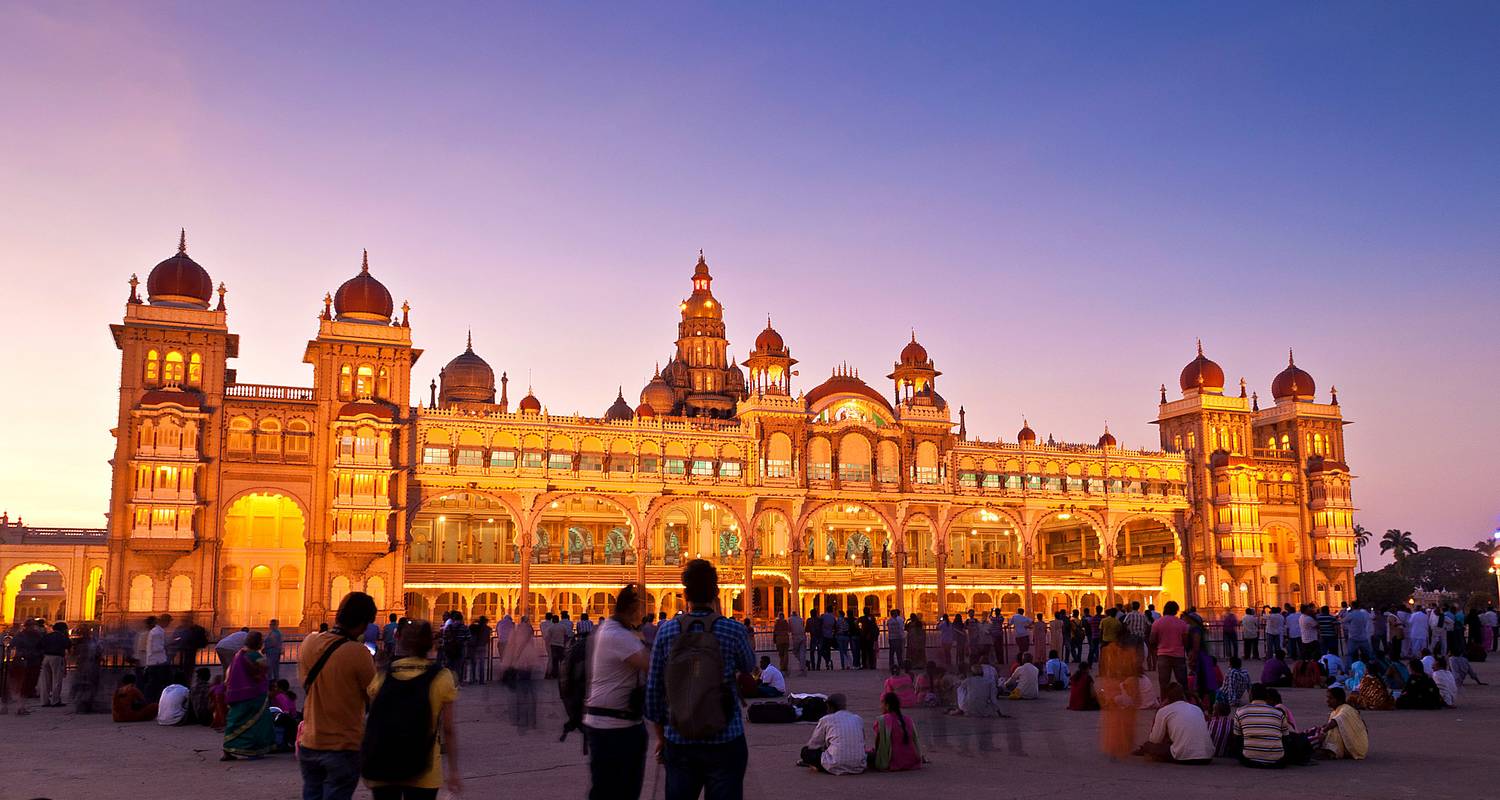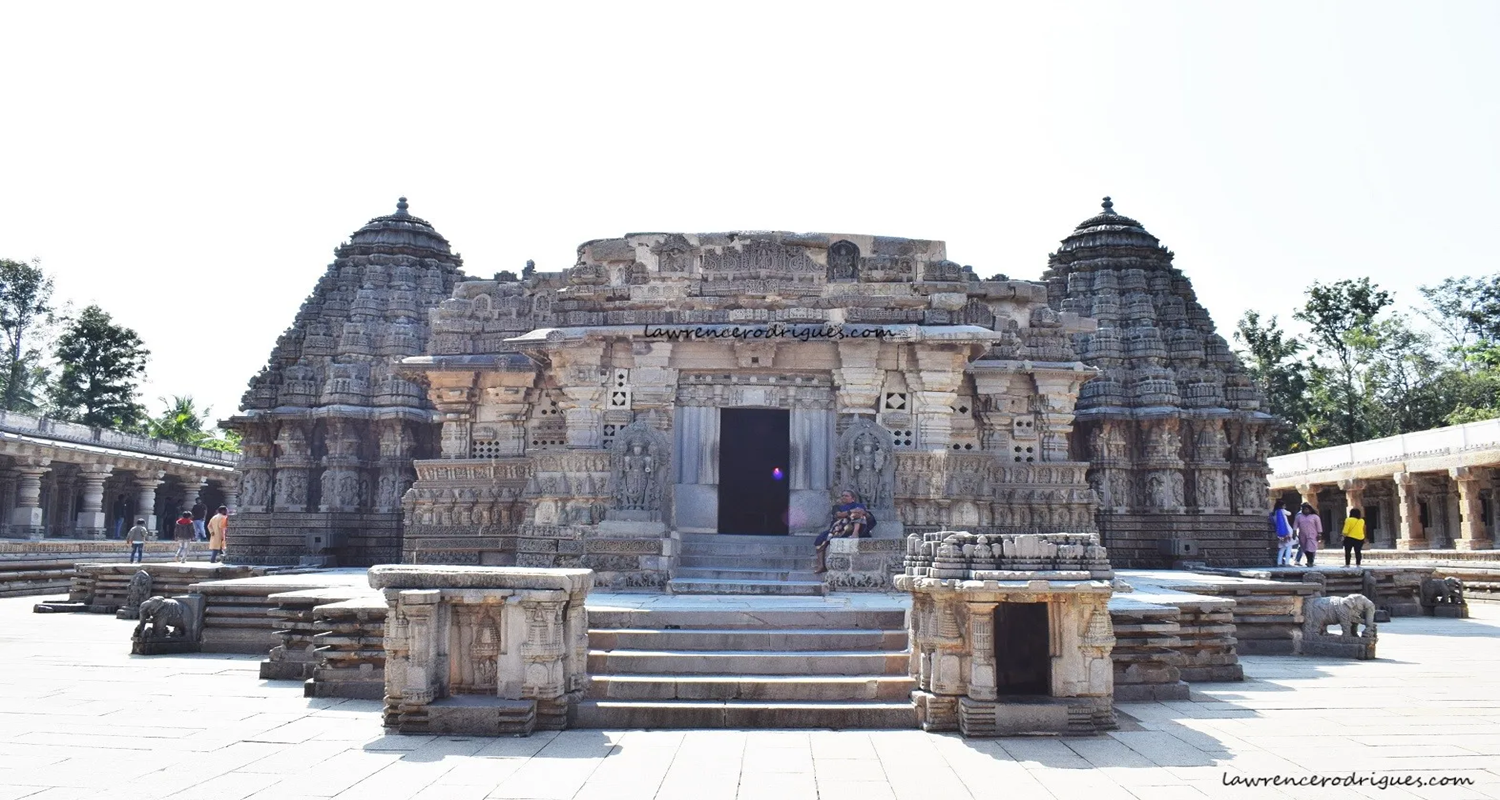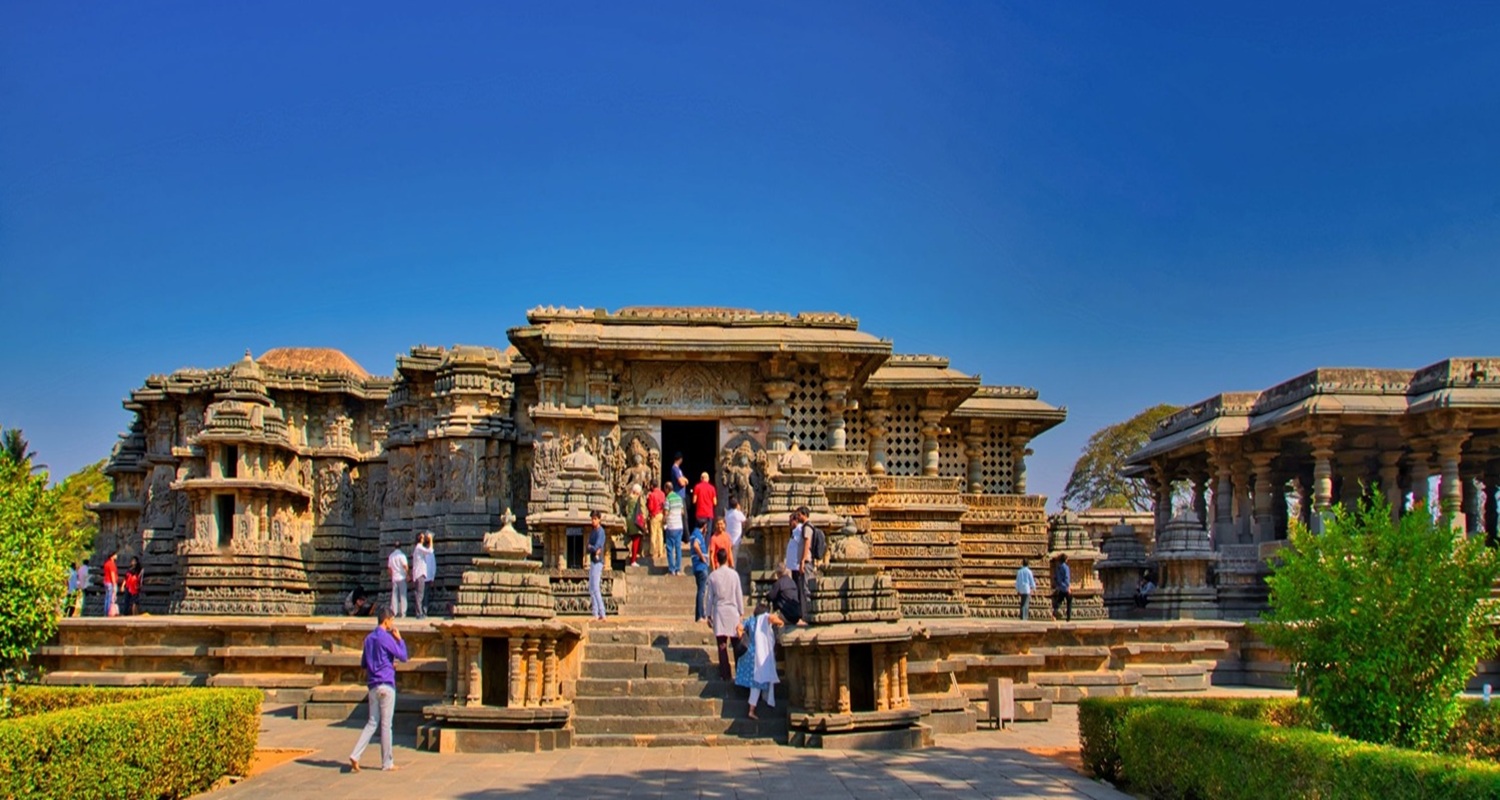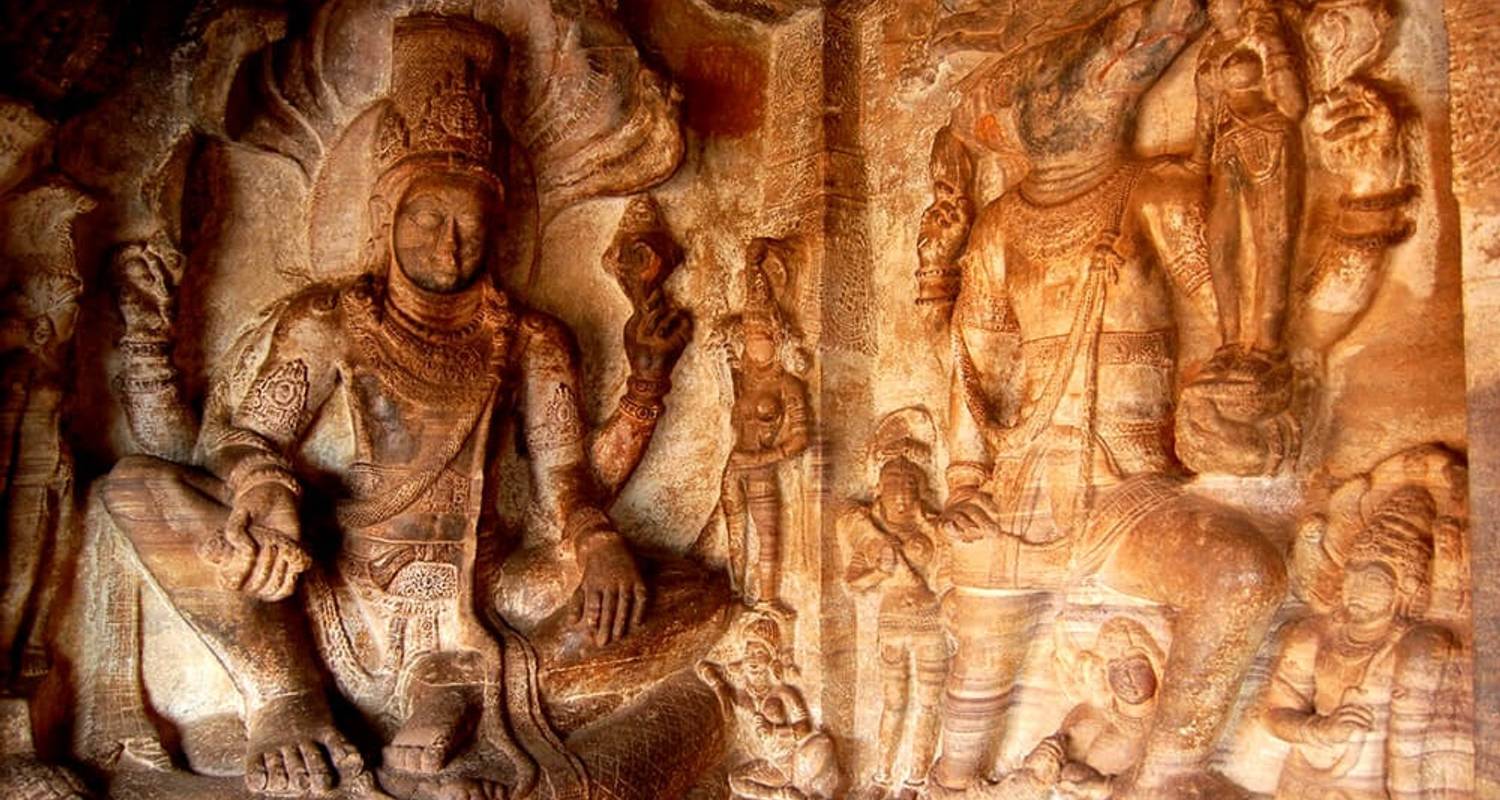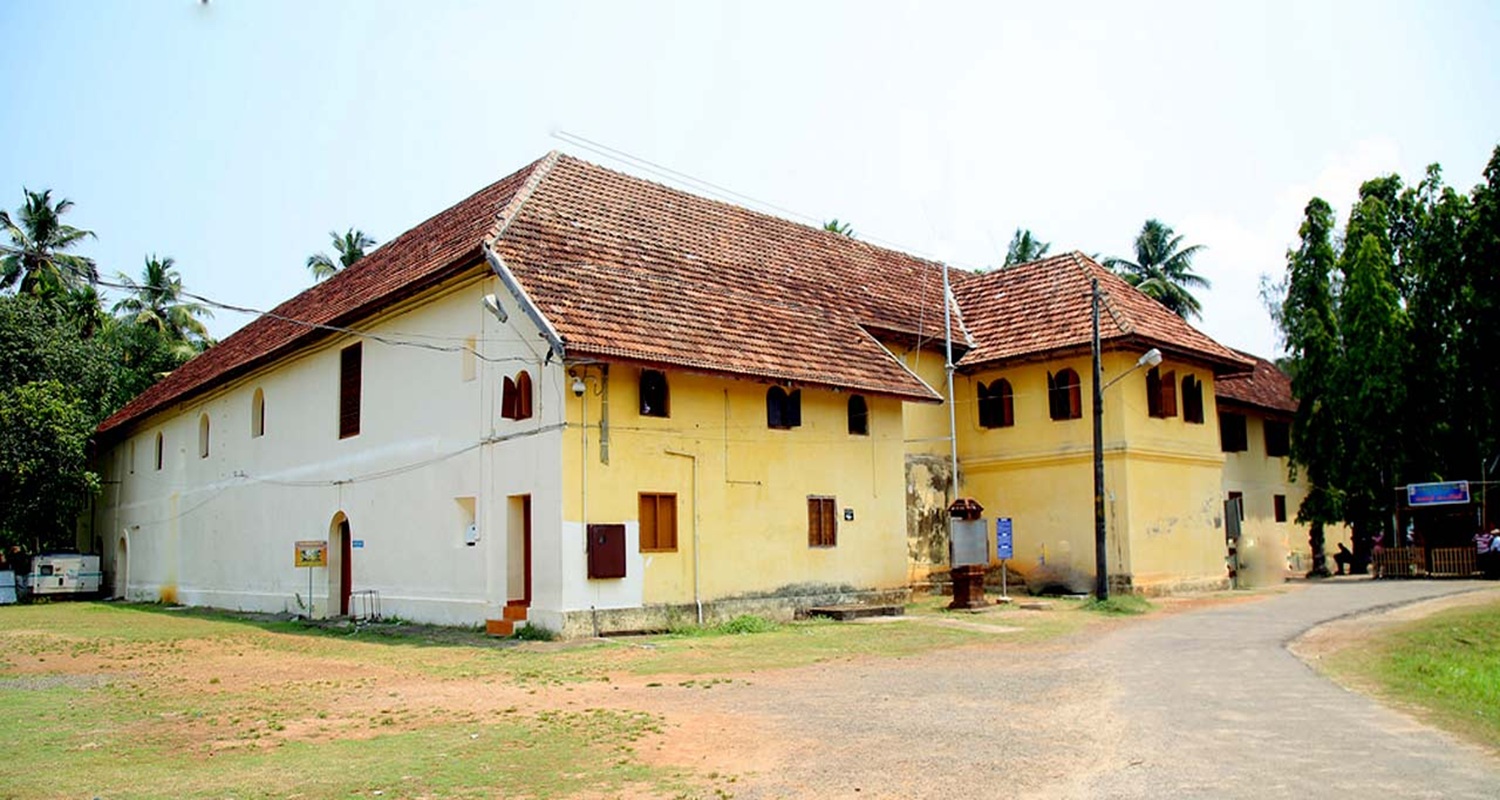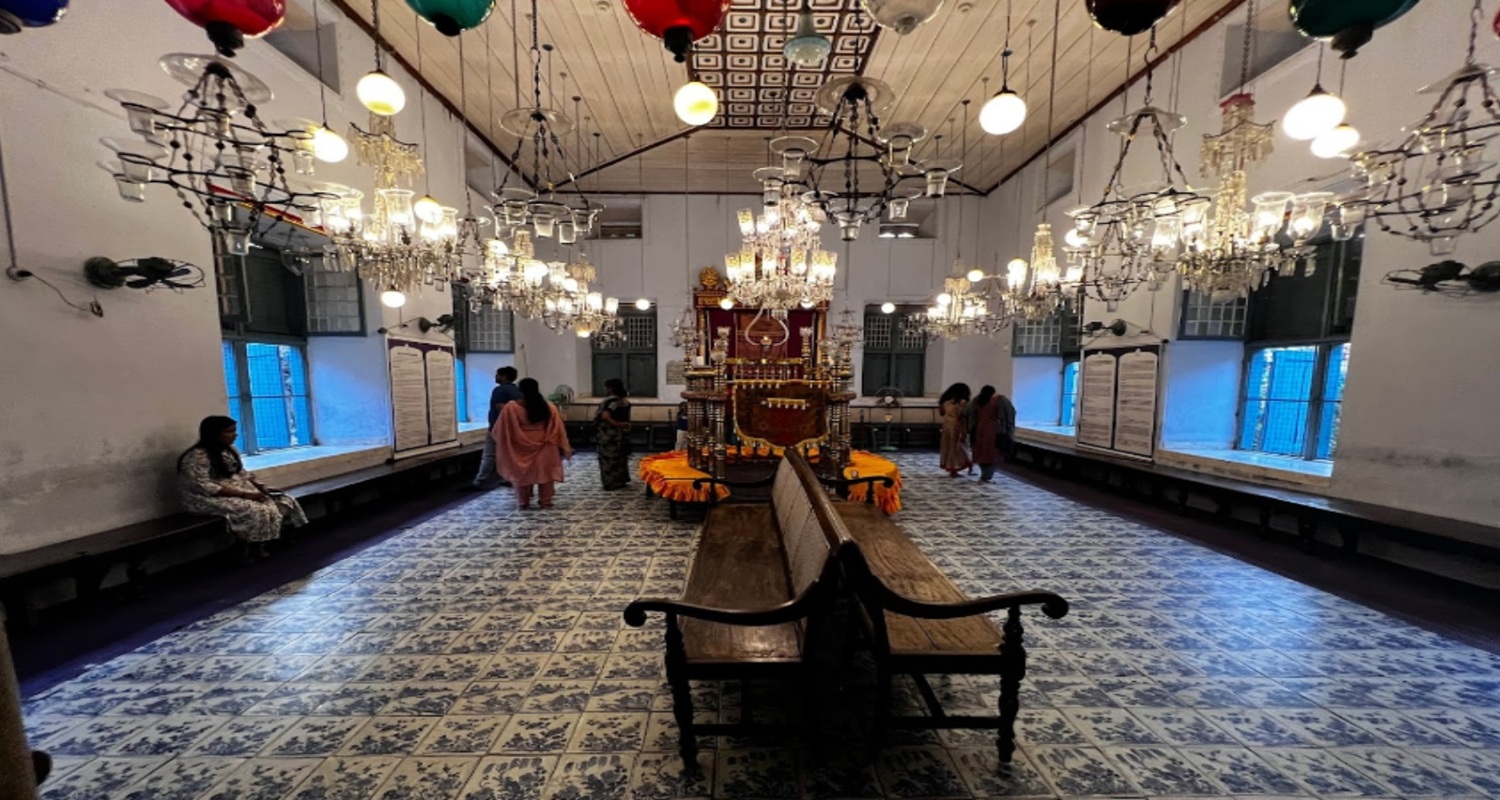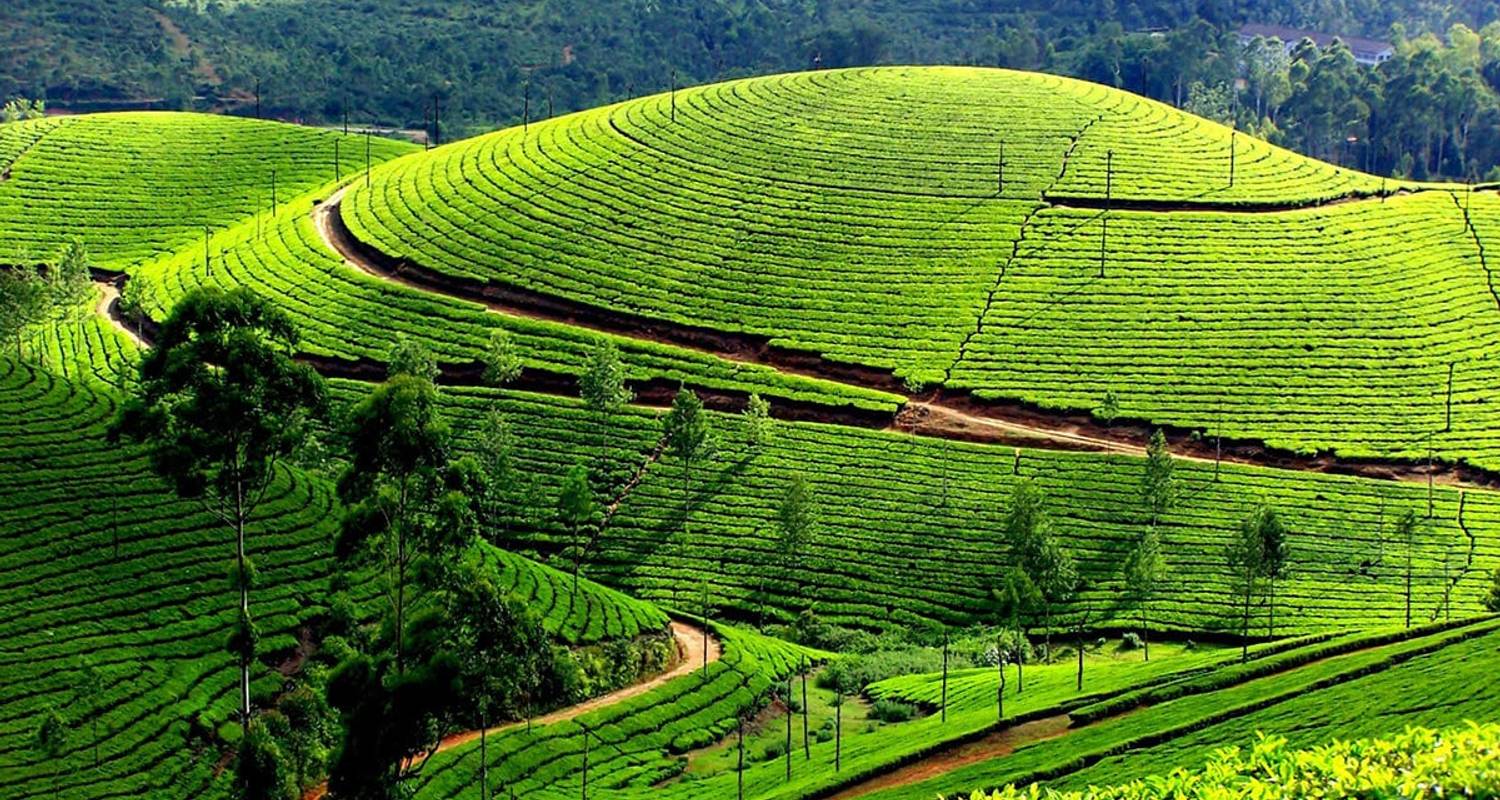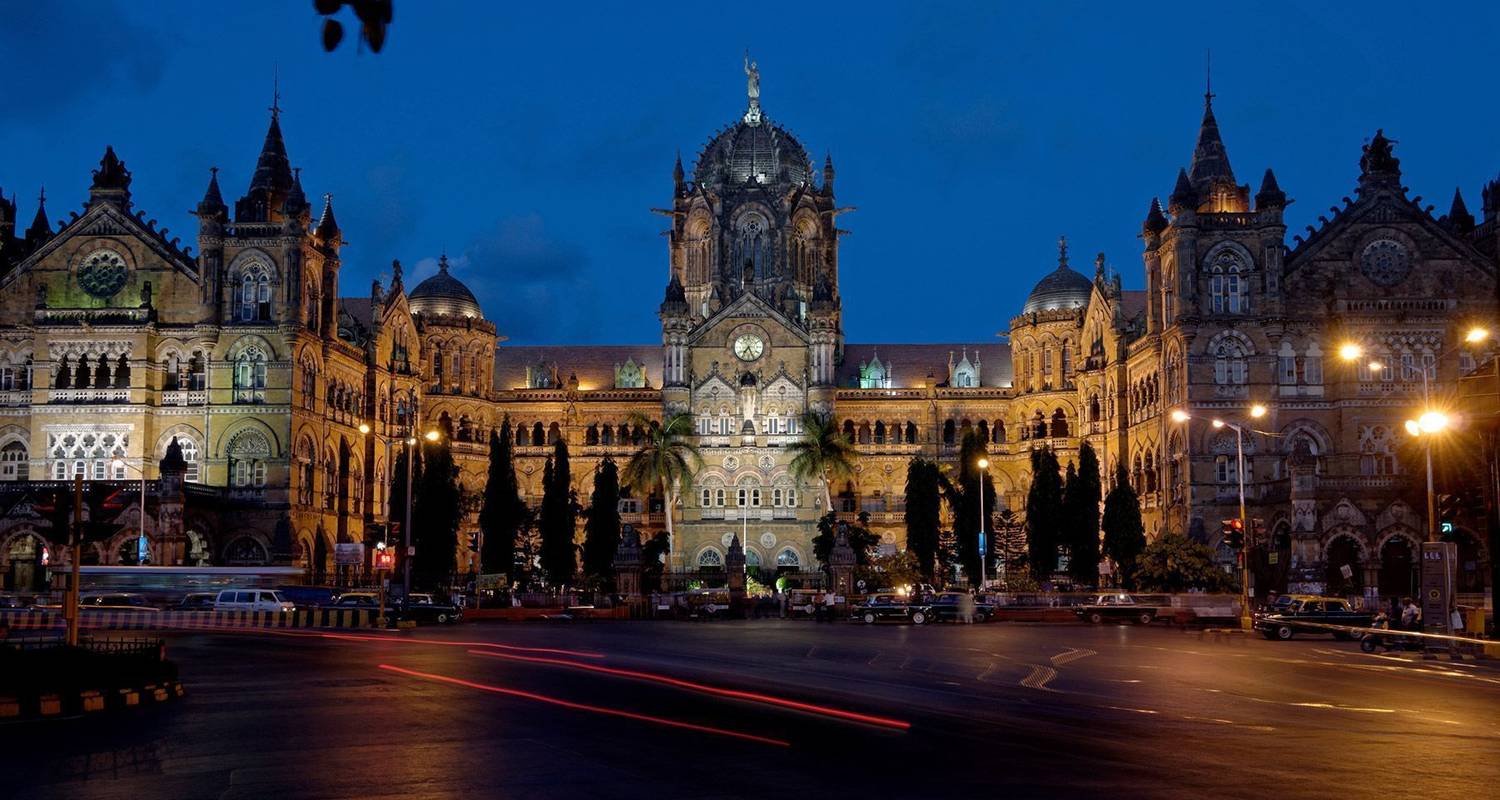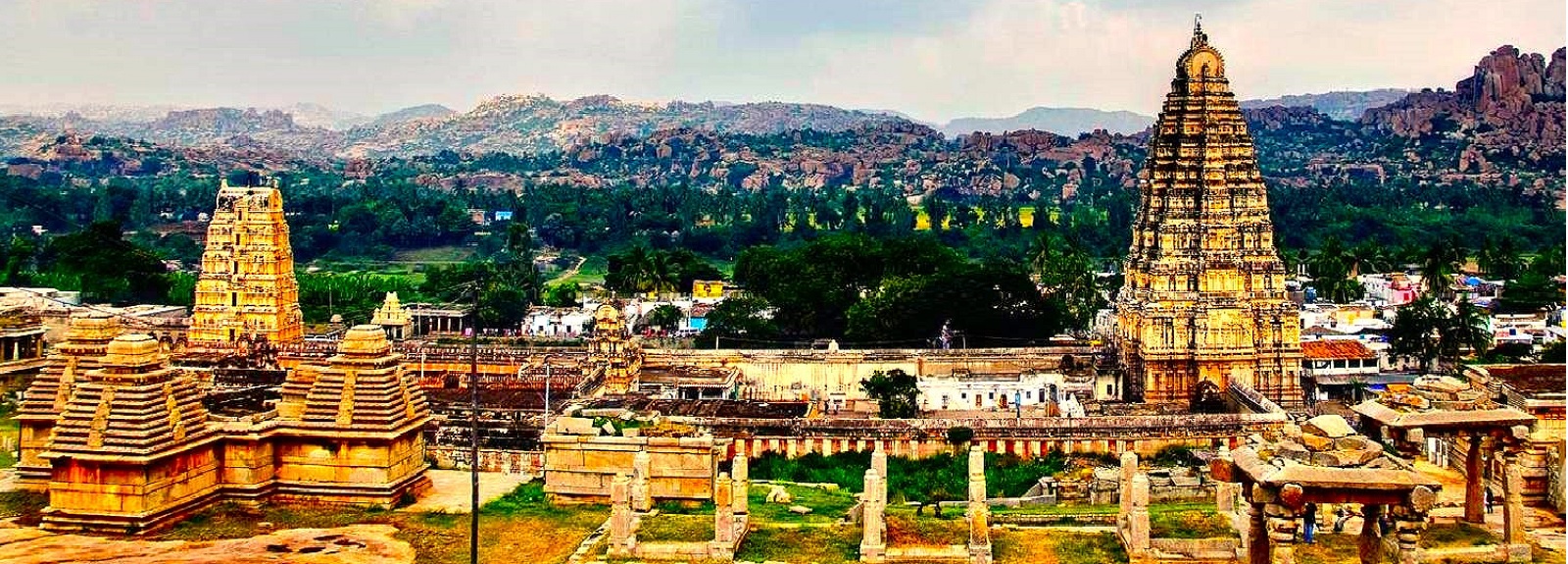
Karnataka
Karnataka & Kerala
Included
INR 107000 Per Person
3-4-5 stars
Travel Duration
16 Days / 15 Nights
Included in the trip
Individual departures
Round The Year
Discover the vibrant landscapes and rich cultural tapestry of South India on this expertly curated journey through Karnataka and Kerala by My Tour Advisor. From palace-strewn hill cities to tranquil backwaters, tropical forests to ancient temples, this itinerary showcases the best of two states that contrast and complement each other beautifully.
Start in Karnataka, where you’ll explore regal Mysore with its grand palace and silk markets, and then delve into Karnataka’s storied past at Hampi or Belur & Halebidu (depending on the specific schedule). Experience the coffee-scented hills of Coorg (Kodagu), the verdant valleys of Wayanad, or the wildlife-rich forests of Nagarhole — where nature’s rhythms take over.
Then cross into Kerala, where life slows down, and every moment seems wrapped in green. Glide along the iconic backwaters of Alleppey in a houseboat, surrounded by swaying palms and reflective waters. Visit Kochi’s historic streets, forts and spice-scented lanes. Relax on a beach in Varkala, take an Ayurvedic spa session, and witness traditions and rituals that are centuries-old. Whether it’s tea plantations, misty hills, or serene lakes, Kerala brings you the gentle side of India.
Throughout the journey, My Tour Advisor ensures seamless travel with comfortable accommodations, private transport, expert local guides, and thoughtfully selected experiences that go beyond sightseeing. This tour is ideal for travellers seeking diversity — heritage, nature, wildlife, tranquility — in one voyage.
In short: Karnataka & Kerala with My Tour Advisor is not just a holiday—it’s a discovery of hidden India, where tradition meets lush landscapes, and every day brings a new chapter of wonder.
Stages Of Tour
Day 1
ARRIVAL IN MUMBAI & SIGHTSEEING
Welcome to Mumbai, The Financial capital of India. Your flight would land at Mumbai International Airport. After landing kindly head towards the immigration department and get your passport stamped. Immigration Department would stamp the Visa on your Passport. After the Immigration and Custom check kindly take an exit from the Airport. My Tour Advisor’s Representative would be waiting for you to welcome you outside the Exit Gate.
Mumbai, formerly known as Bombay, has a rich and layered history that mirrors India’s transformation over centuries. Once a cluster of seven islands inhabited by the Koli fishing community, it came under Portuguese control in the 16th century and was later handed over to the British as part of the dowry of Catherine of Braganza in 1661. The British East India Company recognized its strategic value and developed it into a major trading and maritime hub. With the opening of the Suez Canal in 1869, Mumbai became the gateway of India’s trade with the world. The city flourished as an industrial and cultural center, attracting migrants from across the country. Its colonial architecture, like the Gateway of India and Chhatrapati Shivaji Terminus, stands as a reminder of its past grandeur. Today, Mumbai remains a bustling metropolis—where history, ambition, and diversity coexist in a uniquely dynamic rhythm.
Start the visit of the city with its important monuments starting with Mani Bhawan, It is a historic building located, closely associated with Mahatma Gandhi's life and the Indian freedom struggle. From 1917 to 1934, it served as Gandhi’s residence during his visits to the city. It was here that he initiated major movements like non-cooperation, Satyagraha, and Swadeshi. Now converted into a museum and research center, Mani Bhawan houses a library, photo galleries, personal belongings, and a replica of Gandhi's room. The building offers deep insight into Gandhi’s life, philosophy, and leadership in India's independence movement. It remains a place of inspiration for visitors from around the world.
Later visit Chhatrapati Shivaji Maharaj Terminus (formerly Victoria Terminus) is a historic railway station located in Mumbai, India, and is one of the city's most iconic landmarks. Built in 1887 to commemorate Queen Victoria’s Golden Jubilee, it was designed by British architect Frederick William Stevens in a striking blend of Victorian Gothic Revival and traditional Indian architecture. The station features a grand central dome, pointed arches, turrets, and intricately carved stonework, making it a masterpiece of 19th-century railway architecture. Declared a UNESCO World Heritage Site in 2004,. Its architectural beauty and cultural significance make it a must-visit attraction in Mumbai.
Afterwards Proceed to Gateway of India - It is a grand arch, built in 1924 to commemorate the visit of King George V and Queen Mary to India. Overlooking the Arabian Sea, it combines Indo-Saracenic and Islamic architectural styles. It became a symbolic entry point during British rule and also witnessed the departure of the last British troops in 1948. Today, it is a popular tourist attraction and historic landmark. After the visit return to the Hotel. Overnight in Mumbai.
Day 2
MUMBAI – HUBALI – BADAMI (Flight – 1.5 Hrs + 2 Hours Drive)
Badami, located in the Bagalkot district of Karnataka, is a historic town known for its stunning rock-cut cave temples and ancient architecture. Once the capital of the Chalukya dynasty in the 6th to 8th centuries, Badami is famous for its four cave temples carved into red sandstone cliffs, dedicated to Hindu deities like Shiva and Vishnu, as well as Jain and Buddhist influences. The site also features the Agastya Lake, Bhuthanatha temples, and remnants of a fort with watchtowers. Surrounded by rugged sandstone hills, Badami is a significant archaeological and cultural destination, showcasing early Indian rock-cut architecture and sculpture.
After Breakfast transfer to airport to catch the flight for hubali. On arrival meet with our representative and transfer Badami. On Arrival check-in to the Hotel. Overnight in Badami.
Day 3
BADAMI TEMPLES SIGHTSEEING
Full day dedicated to the visit of Badami cave temples. The Badami Cave Temple Complex is a group of four magnificent rock-cut temples carved into the red sandstone cliffs of Badami. Dating back to the 6th to 8th centuries, these temples were built during the reign of the Chalukya dynasty and represent a fine blend of Hindu, Jain, and Buddhist architectural styles.
- Cave 1 is dedicated to Lord Shiva, featuring a striking image of Nataraja with 18 arms in different dance poses.
- Caves 2 and 3 are dedicated to Lord Vishnu, showcasing avatars like Trivikrama and Narasimha, with beautifully detailed carvings.
- Cave 4, smaller and simpler, is a Jain temple with carvings of Mahavira and other Jain Tirthankaras.
The temples are known for their intricate sculptures, ornate pillars, and impressive reliefs, making them a masterpiece of early Indian rock-cut architecture. Overlooking the serene Agastya Lake, the Badami Cave Temples are a major historical and spiritual attraction in South India.
After the visit return to the Hotel. Overnight stay in Badami.
Day 4
BADAMI – PATTADAKAL – AIHOLE – HOSPET (140 km–3 Hour Excluding Stops)
After Breakfast Drive towards Hospet visiting Temples of Pattadakal and Aihole.
Take the first stop at Pattadakal Temples, which is a UNESCO World Heritage Site renowned for their exceptional blend of North Indian (Nagara) and South Indian (Dravidian) architectural styles. Built during the 7th and 8th centuries under the Chalukya dynasty, this temple complex was used for royal coronations and religious ceremonies. It features ten major temples, including the Virupaksha Temple, the largest and most elaborate, built by Queen Lokamahadevi to commemorate her husband's victory over the Pallavas. Other notable temples include Mallikarjuna, Papanatha, and Kashi Vishwanatha, each adorned with intricate carvings depicting scenes from Hindu epics. Pattadakal reflects the artistic and cultural achievements of early Chalukyan architecture.
Afterwards proceed towards the Aihole Group of Temples, located in Karnataka, is often referred to as the "Cradle of Indian Temple Architecture." This historic site was a major cultural and architectural center of the Chalukya dynasty between the 6th and 8th centuries. Aihole has over 120 temples, showcasing a wide variety of architectural styles, both Dravidian (Southern) and Nagara (Northern).
One of the most famous temples here is the Durga Temple, known for its semi-circular apse, pillared corridor, and intricate carvings. Other notable structures include the Lad Khan Temple, Hucchimalli Temple, and the Ravanaphadi Cave Temple, which contains beautiful rock-cut sculptures of Hindu deities. The temples of Aihole reflect the experimentation and evolution of early Hindu temple architecture, making it a vital site for historians, archaeologists, and architecture enthusiasts.
After the visit transfer to Hospet. On arrival in hospet check-in to the hotel. Overnight in Hospet.
Day 5
HOSPET – EXCUSRSION TO HAMPI
Hampi, located in the southern Indian state of Karnataka, is a captivating historical site and a UNESCO World Heritage monument. Once the glorious capital of the Vijayanagara Empire from the 14th to 16th centuries, Hampi was among the world’s richest and most powerful cities. It served as a major cultural, commercial, and religious hub, attracting traders, artists, and scholars from across the globe. Today, the city lies in ruins, yet retains a mystical charm with its dramatic landscape of granite boulders, lush banana plantations, and the flowing Tungabhadra River, all adding to its surreal beauty.
After Breakfast Head our for an excursion tour of the Hampi. It is particularly renowned for its magnificent chariot temples, which are a testament to the architectural brilliance and spiritual devotion of the Vijayanagara rulers. Arrival at Hampi and visit the Archeological Site of Hampi.
The Virupaksha Temple, dedicated to Lord Shiva, is the oldest functioning temple in India, with origins dating back to the 7th century. The Vittala Temple stands out for its intricately carved stone chariot and musical pillars that emit musical notes when tapped. The Hazara Rama Temple is celebrated for its detailed carvings depicting scenes from the Ramayana. Other notable temples include the Krishna Temple, Achyutaraya Temple, Sasivekalu Ganesha, and Hemakuta Hill temples, each showcasing a unique blend of religious art and stone craftsmanship.
Hampi’s temple complexes not only reflect the religious diversity and architectural sophistication of the time but also tell stories of a once-thriving empire that left behind a legacy carved in stone. It is a must-visit for history lovers, pilgrims, and travelers alike.
After the visit return to the Hotel, Overnight in Hospet.
Day 6
HOSPET – HALEBEEDU – BELUR – HASSAN (300 km – 6 Hours Excluding Stops)
After an Early Breakfast, Drive Towards Hassan visiting the magnificent temples of Halebeedu and Belur on the way. On arrival visit the Halebeedu Temples – meaning s"old city," it was once the flourishing capital of the Hoysala Empire in the 12th century. The most prominent temples here are the Hoysaleswara Temple and the Kedareshwara Temple, both known for their intricate carvings, detailed friezes, and impressive sculptural artistry.
The Hoysaleswara Temple, dedicated to Lord Shiva, was built during the reign of King Vishnuvardhana. It is particularly admired for its detailed outer walls, which are covered with countless sculptures depicting scenes from Hindu epics like the Ramayana, Mahabharata, and the Bhagavata Purana, as well as images of gods, goddesses, animals, and celestial beings. The temple stands on a star-shaped platform and showcases the signature Hoysala style of soapstone construction with elaborate decoration and no two sculptures alike. The twin sanctums of Hoysaleswara and Shantaleswara (named after the king and his queen) add to the uniqueness of the temple, while the finely lathed pillars and ceiling work demonstrate the artisans’ mastery. Despite being incomplete and having suffered damage over centuries, the Halebeedu temples remain a treasured heritage site and a testament to the sophistication and devotion of Hoysala-era craftsmanship.
Later proceed to visit Belur Temples. Also known as the Chennakesava Temple, is a masterpiece of Hoysala architecture located in the town of Belur in Karnataka. Built in the 12th century by King Vishnuvardhana to commemorate his victory over the Cholas, the temple is dedicated to Lord Chennakesava, a form of Vishnu. It took over a century to complete and is celebrated for its exquisite craftsmanship, intricate carvings, and detailed sculptures. The temple stands on a star-shaped platform and features a richly decorated entrance, ornate ceilings, and finely carved pillars. Its exterior walls are adorned with rows of sculptures depicting gods, goddesses, dancers, musicians, animals, and scenes from Hindu epics like the Ramayana and Mahabharata. The famous Madanikas, graceful bracket figures carved in various dance poses, showcase the artistic brilliance of Hoysala sculptors. Belur Temple not only served as a center of worship but also as a symbol of the Hoysala Empire’s power and devotion. It continues to attract visitors and devotees from across the world for its historical, cultural, and architectural significance.
After the visit transfer to Hassan. On Arrival check-in. Overnight in Hassan.
Day 7
HASSAN – SRAVANBELGOLA – MYSORE (150KM – 4 Hrs Excluding Stops)
Mysore, often called the Cultural Capital of Karnataka, is a city where royal heritage, art, and tradition beautifully blend together. Once the seat of the mighty Wodeyar dynasty, Mysore flourished as a centre of architecture, music, painting, and craftsmanship. The iconic Mysore Palace, with its Indo-Saracenic grandeur and glowing illumination on Sundays, stands as the city’s proud emblem. Mysore is also known for the world-famous Dasara Festival, a 10-day celebration showcasing royal processions, cultural performances, and deep-rooted traditions.
Beyond its palaces, Mysore captivates visitors with its serene gardens, vibrant markets, and the fragrance of Mysore sandalwood and silk sarees. Chamundi Hill, with its ancient temple dedicated to Goddess Chamundeshwari, overlooks the city like a guardian. With its clean, laid-back charm and regal past, Mysore offers an unforgettable cultural experience.
After breakfast drive towards mysore, on the way visit of Sravanbelgola – one of the most revered jain pilgrim centre. Arrive and visit of the Sravanbelgola Temple, It is a prominent Jain pilgrimage site located in the Hassan district of Karnataka, known for its spiritual significance, ancient monuments, and the world’s tallest monolithic statue. The town is nestled between two hills—Vindhyagiri and Chandragiri—and holds great importance in Jain history and heritage. The most iconic feature of Shravanabelagola is the **57-foot-tall statue of Lord Bahubali (Gommateshwara), carved from a single block of granite and located atop Vindhyagiri Hill. Erected in 981 AD by the Ganga general Chamundaraya, the statue symbolizes peace, non-violence, and renunciation. To reach the statue, visitors must climb over 600 steps carved into the hill, offering panoramic views of the surrounding landscape. The serene expression and detailed artistry of the statue make it a marvel of ancient Indian sculpture. Chandragiri Hill nearby houses smaller shrines and memorials dedicated to Jain monks and saints, some dating back to the 3rd century BCE. Every 12 years, Shravanabelagola hosts the Mahamastakabhisheka, a grand Jain ritual where the statue of Bahubali is bathed in milk, saffron, ghee, and sandalwood paste, drawing thousands of pilgrims and tourists from around the world. The site is not only a spiritual center but also an architectural and cultural treasure, reflecting the deep roots of Jainism in Karnataka’s history.
After the Visit transfer to MYSORE. On Arrival check-in to the Hotel. overnight in Mysore.
Day 8
MYSORE – SOMNATHPUR - MYSORE
After Breakfast transfer to somanthpur to visit the chennakeshava temple at Somanathapura, also known as the Keshava Temple, is a remarkable example of Hoysala architecture located in the Mysuru district of Karnataka. Commissioned in 1258 CE by Somanatha Dandanayaka, a general under Hoysala King Narasimha III, the temple was part of a broader initiative to establish an Agrahara, A scholarly and religious settlement. This temple stands as a testament to the artistic and cultural zenith of the Hoysala Empire. Architecturally, the temple is renowned for its star-shaped platform and the trikutachala layout, featuring three sanctums dedicated to different forms of Lord Vishnu: Keshava, Janardhana, and Venugopala. The temple's design exemplifies the Vesara style, a harmonious blend of Dravidian and Nagara architectural elements. Intricate carvings adorn the temple walls, depicting scenes from Hindu epics such as the Ramayana, Mahabharata, and Bhagavata Purana, as well as various deities, dancers, and musicians. The use of soapstone allowed artisans to achieve a high level of detail in their sculptures, showcasing the craftsmanship of the Hoysala period
Later return to the city to visit the Mysore Palace a magnificent residence of the Maharajas built in the first half of the twentieth century in indo – Saracenic style. The Mysore Palace, also known as the Amba Vilas Palace, is one of the most magnificent and iconic royal residences in India. Located in the heart of Mysuru, Karnataka, it was the seat of the Wadiyar dynasty, who ruled the Kingdom of Mysore for over five centuries. The present structure was commissioned in 1897 after the old wooden palace was destroyed by fire and was completed in 1912. Designed by British architect Henry Irwin, the palace is a stunning example of the Indo-Saracenic architectural style, blending Hindu, Mughal, Rajput, and Gothic elements.
Afterwards to return to the Hotel. Overnight in Mysore.
Day 9
MYSORE – BANGLORE – COCHIN (210 KM – 5 Hours + 1 Hour Flight)
After breakfast transfer to Banglore. On the Way Visit the Banglore Palace. It is located in the city of Bengaluru, Karnataka, is a striking example of Tudor-style architecture, inspired by England’s Windsor Castle. Built in 1878 by Chamaraja Wadiyar, the palace served as a royal residence for the Wadiyar dynasty. It features fortified towers, battlements, turrets, and elegant woodwork, particularly in its interiors, which are adorned with stained glass windows, Victorian-style furniture, and ornate carvings.
Set amidst a sprawling estate of around 400 acres, the palace once hosted lavish royal gatherings and cultural events. Today, it is open to the public and serves as a venue for exhibitions, concerts, and private events. The interiors offer a glimpse into royal life, with its opulent halls, family portraits, and a mix of European and Indian design elements. Bangalore Palace stands as a prominent cultural and historical landmark in the city, reflecting the grandeur and influence of the Wadiyars during colonial times.
After the visit transfer to Banglore Airport to catch the flight for Kochin. After arriving at the airport meet with our representative and transfer to Hotel for Check-in. Overnight in Cochin.
Day 10
COCHIN SIGHTSEEING
Kochi, often called the Queen of the Arabian Sea, is a charming coastal city in Kerala that beautifully blends colonial heritage, maritime history, and vibrant local culture. Once a major spice trading port, Kochi attracted traders from Arabia, China, Portugal, and Britain — influences still visible in its architecture, cuisine, and traditions. The city’s historic Fort Kochi area, with its narrow lanes, Chinese fishing nets, and colonial-era buildings, exudes an old-world charm. Landmarks like the St. Francis Church, Dutch Palace, and Jewish Synagogue tell stories of a multicultural past, while the lively Marine Drive and art-filled Mattancherry showcase Kochi’s modern spirit. With serene backwaters, colorful festivals, and mouthwatering seafood, Kochi serves as a perfect gateway to Kerala’s beauty and warmth. A harmonious blend of history, art, and coastal serenity, Kochi offers travelers a relaxed yet enriching experience at the crossroads of cultures.
After the Breakfast visit of the city, Starting with Mattancherry Palace - also known as the Dutch Palace, is one of Kochi’s most treasured heritage sites, reflecting a blend of Portuguese, Dutch, and traditional Kerala architecture. Originally built by the Portuguese in 1555 and later renovated by the Dutch, the palace was a gift to the Raja of Cochin. Its modest exterior contrasts beautifully with the richly decorated interiors, featuring exquisite murals depicting scenes from the Ramayana and Mahabharata, royal portraits, and period artifacts. The central courtyard houses a revered temple dedicated to the royal deity, Pazhayannur Bhagavathi. A visit to Mattancherry Palace offers a fascinating glimpse into Kerala’s royal history and artistic grandeur.
After the palace visit proceed towards Jews Synagogue - Also called as the Paradesi Synagogue, located in Jew Town, Mattancherry, Kochi, is the oldest active synagogue in the Commonwealth, built in 1568 by the Paradesi Jews (Sephardic Jews of Spanish and Portuguese descent). It features stunning interiors, including hand-painted Chinese porcelain tiles, Belgian glass chandeliers, and a gold pulpit. The synagogue also houses rare scrolls of the Torah and ancient copper plates recording the privileges granted to the Jewish community by local rulers. Still functioning as a place of worship, it stands as a beautiful symbol of Kochi’s multicultural past and the once-thriving Jewish presence in Kerala.
Later visit St. Francis Church, It is one of the oldest European churches in India, originally built in 1503 by Portuguese Franciscan friars. It holds great historical importance as it once housed the tomb of Vasco da Gama, the famous Portuguese explorer, before his remains were moved to Lisbon. The church’s simple yet elegant design reflects early Portuguese architecture, with wooden ceilings, colonial-era tombstones, and serene interiors. Today, it stands as a symbol of Kerala’s colonial heritage and religious harmony, attracting history lovers and pilgrims alike.
End your day with a visit of Chinese Fishing Nets - chinese fishing nets in Fort Kochi are iconic shore-operated lift nets believed to have been introduced by Chinese traders in the 14th century. These massive wooden structures are fixed to the land and operated by a unique counterweight system. Stretching out into the sea, they create a striking silhouette, especially at sunset. Still in use today, they offer a glimpse into Kochi’s rich maritime history and traditional fishing practices.
After the visit return to the Hotel. Overnight in Kochi.
Day 11
COCHIN – MUNNAR (145 KM – 4 Hrs Approx)
Munnar, located in the Western Ghats of Kerala, is one of South India's most popular and picturesque hill stations. Nestled at an altitude of around 1,600 meters, it is renowned for its sprawling tea plantations, mist-covered hills, and cool climate. Once a summer retreat for British officials during colonial times, Munnar is now a haven for nature lovers, honeymooners, and adventure seekers. The town is surrounded by lush green valleys, waterfalls, winding roads, and wildlife sanctuaries. Key attractions include Eravikulam National Park, home to the endangered Nilgiri Tahr, the Tea Museum, Mattupetty Dam, and Anamudi Peak, The highest in South India. Munnar also offers opportunities for trekking, boating, and visiting spice gardens. The scenic beauty, fresh mountain air, and peaceful ambiance make it an ideal getaway from city life. Munnar’s charm lies in its blend of natural splendor, colonial history, and vibrant local culture.
After breakfast. Start your drive towards munnar. On Arrival check-in to the Hotel. In the Afternoon Relax in your Hotel. In the evening you can take a stroll in the town or go hiking in the mountains.
Overnight in Munnar
Day 12
MUNNAR
After Breakfast head out to visit Eravikulam National Park, located just 13 km from Munnar, is one of Kerala’s most scenic and well-preserved wildlife sanctuaries. Spread across rolling hills of the Western Ghats, it is home to the endangered Nilgiri Tahr and over 130 species of birds and butterflies. The park’s mist-covered landscapes, lush valleys, and panoramic viewpoints offer breathtaking views of Anamudi Peak, South India’s highest point. Visitors can enjoy a guided eco-bus ride followed by a light trek to explore its pristine beauty. During the blooming season, the hills turn blue with the rare Neelakurinji flowers, which blossom once every twelve years.
Afterwards you can proceed towards Mattupetty Dam, located about 13 km from Munnar, is a beautiful hill-country reservoir surrounded by rolling tea gardens and lush green hills. Built in the 1950s for hydroelectric power generation, the dam has now become one of Munnar’s most popular attractions. The serene lake formed by the dam offers opportunities for boating, photography, and picnics amidst stunning natural scenery. The calm waters often reflect the surrounding forests and misty peaks, creating postcard-perfect views. The area is also known for sightings of elephants and native birds, making it a delightful stop for both nature lovers and photographers exploring the Munnar region.
Later visit a Tea Production Factory, which will offer you a glimpse into the region’s century-old tea-making tradition. These factories showcase the complete process — from plucking tender tea leaves to drying, rolling, and packaging. Visitors can walk through aromatic processing rooms, observe workers at different stages, and learn about the fine art of tea grading. It’s an immersive experience that blends history, culture, and the soothing charm of Kerala’s lush tea-covered hills.
Later Return to the hotel. Overnight in Munnar.
Day 13
MUNNAR – THEKKADY (100 Km | 2 Hours)
Thekkady, located in the Idukki district of Kerala, is a beautiful hill station renowned for its lush greenery, wildlife, and spice plantations. Nestled in the Western Ghats near the Kerala-Tamil Nadu border, Thekkady offers a tranquil escape into nature and is a must-visit destination for wildlife lovers and eco-tourists. Thekkady is equally famous for its spice plantations, especially cardamom, pepper, and cinnamon. Guided plantation walks give insights into spice cultivation and processing. The region’s cool climate, serene forests, and fragrant spice gardens create a refreshing and immersive experience.
Other attractions include trekking, bamboo rafting, elephant rides, and traditional Kalaripayattu performances—a martial art native to Kerala. With its blend of adventure, culture, and natural beauty, thekkady is a perfect destination for those seeking a deeper connection with nature and Kerala’s unique heritage.
After breakfast transfer to thekkady passing through the lush green forests and tea Gardens. On Arrival in thekkady check-in to the hotel. In the Afternoon Head out for Jeep Safari exploring the Lush green mountains of thekkady. The safari offers you a possibility of sighting elephants or other animals of Periyar National Park.
On the return take a stop at spice plantation to get a detailed information on the various spices grown in this region. Return to the Hotel.
In The evening you can go for ayurvedic Massages or other cultural activities offered at nearby Places.
Overnight in Thekkady.
Day 14
THEKKADY – VEMBANAND LAKE ALLEPPEY - KUMARKOM (170 Km | 4 Hours)
Vembanad Lake Alleppey, stretching across the districts of Alappuzha, Kottayam, and Ernakulam, is the largest lake in Kerala and one of India’s longest. This vast expanse of shimmering backwaters forms the heart of Kerala’s unique ecosystem and is the lifeline of its famous houseboat tourism. Fringed by lush coconut groves, paddy fields, and tranquil villages, the lake offers an idyllic setting for cruising on traditional Kettuvallams. It’s also home to migratory birds and the renowned Nehru Trophy Boat Race, held annually at Punnamada Lake. A visit to Vembanad is a peaceful escape into Kerala’s natural beauty, rural charm, and timeless backwater culture.
After Breakfast transfer to Alappuzha to board a houseboat cruise on Vembanad Lake. It is one of Kerala’s most enchanting experiences — a serene journey through tranquil backwaters framed by coconut palms and lush paddy fields. As your traditional Kettuvallam houseboat glides across India’s largest freshwater lake, you can relax on deck, watching village life unfold along the banks — fishermen at work, women washing clothes, and children waving from canoes. The gentle rhythm of the waters, the cool breeze, and the flavours of authentic Kerala cuisine served on board create a truly immersive escape. Sunset over Vembanad paints the sky in gold and crimson, offering a picture-perfect end to a magical day on the backwaters.
After the excursion, Transfer to the Hotel at Kumakom for check-in. Overnight stay in Kumarkom
Day 15
KUMARKOM
Kumarakom, located near Kottayam in Kerala, is a tranquil village famous for its backwaters, bird sanctuary, and scenic beauty. Set along the Vembanad Lake, the largest lake in Kerala, Kumarakom is a popular destination for houseboat cruises that offer a peaceful journey through winding canals, lush paddy fields, and coconut groves. The Kumarakom Bird Sanctuary is a haven for bird watchers, home to species like kingfishers, herons, egrets, and migratory birds like the Siberian crane. Known for its luxury resorts, Ayurvedic spas, and authentic Kerala cuisine, Kumarakom is ideal for those seeking relaxation, nature, and a taste of Kerala’s village charm.
Full Day Dedicated to Relax and Leisure. Kumarkom hotels are famous for their traditional Kerala-style architecture, tranquil ambience, and stunning water views. Guests can enjoy unique experiences like houseboat cruises, canoe rides, fishing, and guided village walks, all starting right from the resort’s private jetties. Many resorts are known for their world-class Ayurvedic wellness centers, offering massages, yoga, and detox therapies. With beautifully designed villas, lake-facing cottages, and private pools, the accommodations blend heritage with modern comfort. Most resorts also serve authentic Kerala cuisine, often with live cooking and fresh local ingredients, making the stay in Kumarakom a perfect mix of relaxation, nature, and culture.
Overnight stay in Kumarkom.
Day 16
KUMARKOM – COCHIN - DEPARTURE
Morning at leisure. In the Afternoon Transfer to Kochin Airport to catch the flight for your onward Destination.
END OF THE SERVICES.
The hotels
My Tour Advisor Provides a wide variety of hotels
Cost Per Person For Different Categories
| # | No of Pax | Standard | Superior | Prestige |
|---|---|---|---|---|
| 1 | 2 Pax | INR 143238 | INR 169000 | INR 205000 |
| 2 | 4 Pax | INR 128914 | INR 152133 | INR 184900 |
| 3 | 6 Pax | INR 121752 | INR 143681 | INR 174706 |
| 4 | 8 Pax | INR 114500 | INR 135000 | INR 164400 |
| 5 | 10 Pax | INR 107428 | INR 126777 | INR 154000 |
Supplements
| # | Plan | Standard | Superior | Prestige |
|---|---|---|---|---|
| 1 | Single Supplement | INR 85900 | INR 101000 | INR 123000 |
| 2 | Half Board | INR 6000 | INR 12000 | INR 18000 |
| 3 | Full Board | INR 12000 | INR 24000 | INR 36000 |
| 4 | Christmas Supplement | INR 35000 | INR 42000 | INR 51000 |
| # | Months | Dates 1 | Dates 2 |
|---|
Inclusions
- Accommodation as per Itinerary on twin sharing with Bed and Breakfast Plan.
- Transport by private air conditioned vehicle as per program.
- Professional English Speaking Guide.
- Domestic flight from Mumbai to Hassan in Economy class, 15 Kg of baggage allowance.
- Domestic flight from Banglore to Kochin in Economy class, 15 Kg of baggage allowance.
- Monument Entrances as per the Program.
- Day Excursion at Houseboat with Lunch.
- Mountain Jeep Safari in Periyar
- 2 Bottle of water per passenger per day
- Local Assistance during the tour
- Travel Kit with document folder
- One souvenir gift with compliments from My Tour Advisor.
- GST (Goods and Services Tax)
Exclusions
- International Flight.
- Visa and Insurances.
- Food and drinks, unless specified.
- Gratuities (recommended).
- Anything not mentioned and specified in Itinerary and in inclusions.
TOUR HIGHLIGHTS
In accordance to the COVID 19 pandemic all our tours are operated with all precautionary measures including SANITIZED CARSAND HOTELS/COMPLIMENTARY SANITIZERS/MASKS (Your safety is our priority)
- All Inclusive Tour - Hotels / Transport / Domestic Flights / Guides / Monument Entrances/Backwater
- India’s Commercial Capital Mumbai and Dhobi Ghat
- Hampi World Heritage Archeological Site
- Temples of Belur & Halebid
- Statue of Gomateshwara at Sravanbelagola
- Ooty – the Most Visited Hill Station of South India.
- Boat Ride in Backwaters at Cochin
- More Value for Your Money.
Enquiry Form
Please fill the below form for more information
PASSPORT
A valid passport is required for at least six months before Boarding the Flight. We encourage you to check the validity of the passport and we advise you to bring a photocopy of your passport and the page of the visa obtained, or carry multiple copies of ETA, useful in case of loss.
INDIAN CONSULAR VISA
To enter India, an entry visa issued by the Indian Embassy is required. It is categorically necessary that all travellers, whose itinerary includes leaving and returning to the country, have obtained a double or multiple visas. During the flight to India you will be given a disembarkation form to be filled in with your data and to be delivered to passport control. The detachable part completed with the customs declaration will be returned to you, and must then be handed over to the customs upon leaving the airport.
INTERNAL FLIGHTS
Air tickets for flights within India or between India and Nepal, if not included in the intercontinental flight, will be collected by your companion or our representative and will be delivered to you upon arrival. Flights within India and between Nepal are the trickiest part of the journey. We recommend a lot of patience, because it is not uncommon for flights to suffer delays, cancellations or make intermediate stops not foreseen at the time of booking. It is therefore essential to always go to the airport on time (about 2 hours before the flight). In the event of cancellations, however, the companies, according to the new regulations, will refund the cost of the ticket but have no obligation to re-route. The rebooking will then be done by our local office by purchasing a new ticket. Purchasing it on the same day, the same fare as the canceled flight is not always available. In case this exceeds that of the cancelled flight, the difference must be paid directly on the spot. If there are no other flights on the scheduled route, a land transfer by car/bus will be provided in lieu of the ticket.
DOMESTIC FLIGHTS BAGGAGE ALLOWANCE
Since recently (August 2013) both on intercontinental flights and on internal flights, the companies are very strict in calculating the weight of the baggage and each additional kilogram is subjected to an extra payment according to the rules of the company itself. In this regard, we report the scheme concerning the baggage allowance for the economy class granted by each airline for flights within India and between India and Nepal:
Airline
Hand Baggage Weight
Checkin Luggage Weight
Air India
7 kg + Laptop
15 kg
Jet Airways
7 kg + Laptop
15 kg
Indigo & Spice Jet
7 kg + Laptop
15 kg
Go Air
7 kg + Laptop
15 kg
Jet Lite
7 kg + Laptop
15 kg
The company has the right to apply an extra cost for each kilogram exceeding the above, (indicatively from 4 to 8-euro per kg).
LOCAL GUIDES AND ESCORT TOURS
For the entire duration of the group tour, starting from your arrival in India, you will be assisted by a Tour Escort or local Guide (for individual tourists) in each city who will take care of every technical-organizational detail. The tour escort will also act as a local guide in the cities for which he is licensed. In the others he will be accompanied by a local foreign speaking guide or English-speaking guide as per the provisions of the Indian government. In the latter case, he will provide for the translation.
In many cities of India, in fact, there are no local guides speaking foreign languages (especially in southern India, central India and some parts of Rajasthan), or there are few.
THEFT
We remind you that passport, telephone and valuable accessories in general must always be kept by the passenger and never left unattended, as no service facility takes charge of any loss/theft during the tour. It is also good to have all the emergency bank numbers with you in case of need.
TIPS
In India, tipping is a custom rooted in local custom. The amount of tips is at the discretion of the passengers, but as a rule they are in the local custom. In restaurants it is customary to leave 10% of the bill as a tip.
A basic tip:
For half day drive with driver Rs. 300/ full day Rs. 500.
For porters Rs. 70 per bag
For Half Day Local Guide Rs. 500/ Full Day Rs. 800
Per Day Escorts Rs. 1000
(The amount is in total and refers to a group of 2/3 people, it can be increased if you are traveling in a group with more people)
For groups, even small in number but with tour escorts, it is advisable to give the guide a sum at the beginning of the tour (approximately 40/45 euros for 7/9 day tours) and he will distribute them appropriately, thus avoiding boring and continuous collections.
N.B. (This figure does not include a possible tip for the companion)
ROOM AVAILABILITY
The rooms are available until 12.00 on the day of departure. In India there is no day use system, therefore if the rooms want to be kept until departure they will have to be paid for the entire following night.
CHECK-IN ONLINE
We inform you that the check-in procedure can take place via online check-in, which can be implemented from the airlines' websites or via the automatic check-in devices specifically installed at the airport.
CLIMATE
The most pleasant season runs from mid-November to March, with moderate heat and low rainfall. The maximum temperatures vary from 27° to 30°, the minimums from 16° to 22°. In March the temperatures begin to rise with highs reaching 38°. The month of August records the peak of the monsoon season (from June to October) which invests the south-western regions with rainfall that varies in intensity according to the areas, limited in some to severe thunderstorms. In October and in the first half of November the south-eastern part of India is affected by a north-east monsoon.
CLOTHING
Clothing must take into account the period and the regions where you go. In southern India, light clothing can be worn all year round, without forgetting long trousers and long-sleeved shirts to protect against insects. During visits to the temples, excessively small clothing should be avoided. For those traveling to the northern regions, warmer clothing is needed, as the temperature can approach freezing in winter. In the desert region of Rajasthan the temperature varies a lot between day and night.
SHOPPING
In India the variety of handicraft production is practically infinite. Indian muslins, canvases, silks and brocades have enjoyed worldwide fame since ancient times and have been appreciated for the quality of the fabric, the beauty and resistance of the colors, the originality of the designs. Even today the brightly colored silk saris, embroidered or woven with gold or silver threads, the brocades of Varanasi as well as the cottons of Rajasthan, the wool or wool and silk carpets of Kashmir and Uttar Pradesh are renowned. The manufacture of fabrics is just one aspect of the varied and rich Indian craftsmanship which ranges from wood carving (teak, sandalwood, rosewood, ebony) spread almost everywhere, especially in Karnataka, to Agra marble inlays or the stone sculptures of Orissa, from ceramics to hand-painted lacquers, from brass and copper pottery to bamboo and leather objects. The skill of the Indians in the cutting and processing of semi-precious and precious stones has been known since ancient times. Haggling in the bazaars is common practice.
Do not buy souvenirs that cost animals their lives or harm nature.
FOOD AND DRINK
It is recommended to drink only bottled or boiled water (found in almost all restaurants and hotels). Carefully avoid tap water and ice in drinks. It is advisable to consume only well-cooked foods and packaged foods, avoiding raw vegetables and fruit that cannot be peeled.
MEDICAL ASSISTANCE
In India there is a great variety of doctors practicing the most diverse forms of therapy and the only hospital in Europe is located in Delhi. It is advisable to bring from Italy tablets against any gastrointestinal disorders and medicines that are difficult to find locally.
BEHAVIOUR
Before entering the temples, mosques and or gurdwaras it is essential to take off your shoes, generally it is allowed to keep your socks on. To avoid discomfort, do not bring leather articles of any kind with you, because they could arouse some opposition. Inside places of worship, tourists can move as they please and sometimes attend religious rites, for which it is preferable to wear modest clothes, avoiding tops, skirts and shorts. A small donation will be welcome.
The folded hands namaste is the typical Indian greeting and its use will be greatly appreciated. Especially in cities, men will gladly shake hands with tourists; in fact, this gesture is considered particularly cordial. The majority of Indian women, on the other hand, are reluctant to shake hands with a man, both Indian and foreign (a possible refusal should not be considered an offense) and are generally surprised by the informality of relations between the two sexes used in western countries. In private homes you will be welcomed as guests of honor and your lack of familiarity with local customs and traditions will be understood and accepted. If you should be tempted to eat with your fingers, remember to use onlyyour right hand.
GASTRONOMY
Indian cuisine varies according to the regions, with notable differences between the southern and northern regions, but has as a common feature the wise use of spices which are used not only to flavor foods but also to aid digestion. In the north it looks remarkably like that of Middle Eastern or Central Asian countries; there is great use of chili (hot pepper), the staple food is wheat, and various types of unleavened bread are consumed, such as pooris or chappatis. The meats are quite common, naturally not beef. In the south, where the Muslim influence has been less strong, vegetarian diets prevail, and the cuisine revolves around rice, consumed in an infinite variety of ways. The highly savory taste of Indian foods is related to the blend of spices frequently used in food preparation. These mixtures (kari) can accompany various vegetables, chicken or lamb meat, fish or rice. Rogan josh (lamb curry), gishtaba (spiced meatballs with yoghurt), korna (vegetable meat-based stews) are very common in the north. In the south, various vegetable dishes are widespread, including bhujia (a vegetable curry) and along the coasts, fish dishes, the Cochin prawns are delicious. Perhaps the most common dishes throughout India are, however, the simple dhal, essentially a lentil soup, and the thali, the typical vegetarian dish, usually served on a tray with small bowls full of vegetables accompanied by large -of quantity of rice. Among the desserts, kulfi, the typical pistachio ice cream, is very common, while tropical fruit is very abundant. It is a frequent habit to conclude the meal by chewing pal, a mixture of spices, betel nuts and other powders, all wrapped up in an edible leaf. Tea is the most popular drink and some varieties of Indian tea are famous all over the world. Try the rice beer.
LANGUAGE
In India a large number of local languages are spoken, very different from region to region, among which Hindi is the official one. English represents a strong instrument of national cohesion and is very widespread, especially in hotels or in places frequented by Westerners.
RELIGION
Religion forms an integral part of India's complex tradition. Four of the most important faiths in the world meet on this territory: Hinduism, Buddhism, Christianity and Islam and among these the first two were born in India. furthermore, this country which welcomed the Jews and the Parsees (followers of Zoroaster), who then integrated into Indian life, gave rise to Jainism, Sikhism and other innumerable cults and regional sects of lesser importance and which for centuries have acted and interacted with each other.
AIRPORT FEES
They usually already include exit taxes from the country. However, we recommend checking at the airport, as these are subject to change regulations.
PHONE
The cellular network is active in the country, however Italian cell phones are only active in the main cities and it is therefore advisable to purchase a card locally. To call from India the area code is 0039. To call India dial 0091.
VACCINATIONS
No mandatory vaccination is required for travelers from Italy. Before travelling, it is advisable to consult the competent ASL on the need to carry out vaccinations or appropriate prophylaxis. In general, subject to medical opinion, vaccinations against: diphtheria, hepatitis A and B, typhoid, tuberculosis, polio and tetanus booster are recommended. However, we recommend checking the Viaggiare Sicuri website at the link http://www.viaggiaresicuri.it/index.php?india
CURRENCY
The legal tender in India is the Indian Rupee. It is advisable to have currency in US dollars especially for entrances, Euros are also welcome. No Indian currency can be brought into the country or exported, while any amount of foreign currency can be imported. It is very complicated to exchange the Rupee in another currency, so it is advisable to buy in such quantities as to no longer have liquids in local currency at the time of departure. Credit cards, preferably from the VISA circuit, are accepted both in authorized shops and in hotels in large cities, where automated bank branches can also be used.
Our Staff
Our guides and professional escorts have experience in the area and in-depth cultural preparation. We can provide Guides in differenr languages also in most of the sectors but in some areas there shall be only english speaking Guides available, Such as Ladakh and the Himalayan areas, Kindly do check it with our travel experts regarding the availabiluty.
Means of transport
Our organization boasts a large fleet of new generation air-conditioned means of transport: from standard or deluxe cars (2/3 pax) to Overland vehicles (2/3 pax); from minibuses (4/8 pax) to grand tour buses (10/40 pax), with professional English speaking drivers, always attentive to the needs of travelers. The roads that connect the main cities of India are generally good. Indian Traffic conditions limit the transfer times to an average of 50 km per hour.
Hotels and tented camps
In Indian Subcontinent, the official category of hotels does not guarantee international standards and does not always correspond to the expectations of the traveler. The structures that MTA chooses, from luxury hotels, to Heritage Hotels (former residences of the Maharajas), to lower category hotels, are periodically supervised by our staff. In the Himalayan areas of Ladakh, hotels are provided among the best existing and standard tented camps with limited comfort, where a good spirit of adaptation is required.
Flights
The Major airports where International flights Land are Delhi, Mumbai, Chennai, Kolkata, Bangalore, Hyderabad, Almost all of the major International Airliens have theor scheduled flights from these cities. including Swiss, Emirates, Qatar Airways, Turkish Airlines, BrusselsAirlines and Etihad.
Personalized trips
Our Product Managers are available to travelers to develop personalized itineraries (for individuals or groups) and offer ad hoc programming, designed with maximum flexibility and with smallest details, for those who want to immerse themselves in the magic and spirituality of " Land of the Gods” outside the classic Itineraries or with programs already present in the catalog. MTA is also available to develop personalized travels in cinema, nature, sports, honeymoons, incentive travel, business tourism and medical tourism in India.
India Visa
To obtain an entry visa to India it is essential to have a passport valid for 6 months from the date of travel (with at least three consecutive free pages), and two passport photos. you can apply for ETA (Electronic Travel Authorization) The Link of the website is https://indianvisaonline.gov.in/evisa/tvoa Kindly check for permission Granted on ETA before boarding your flight.
